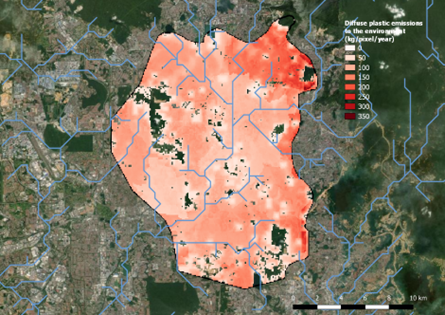UNESCAP
Research indicates that countries in the ASEAN region contribute substantially to plastic pollution. The 'Closing the Loop' project, an initiative funded by UNESCAP in collaboration with the Japanese Government seeks to address plastic pollution in prominent cities in the ASEAN region. To assist with this project, we applied the ISWA Plastic Pollution Calculator in four multi-city regions to assess plastic emissions and propose and tailor interventions to mitigate them.
Data collection
We collected comprehensive environmental, waste management and governance data from municipal authorities in each of the four participating metropolitan areas:
Our-on-the-ground research partners carried out surveys to determine waste generation and the variance in item composition between different waste generating sources, such as commercial, residential (multi and single family dwellings) and institutional. We assessed the level of waste containment and collection service quality as well as user-behaviour such as open burning and open dumping.
Modelling
Our models mapped plastic waste flowing through societal systems to identify points of emission and then map the flow of debris through terrestrial and aquatic compartments. We wanted to know:
- What type of plastic products are emitted into our waterways?
- From where in the waste management process does plastic enter the environment?
- Where are the primary 'hotspots' of emission and what policy solutions will be most effective to mitigate them?

This information provided a baseline assessment of each city's weaknesses and strengths in their waste supply chain. This is the first step to identifying the measures that need to be taken to stop plastic pollution.

Spatial distribution of plastic emissions in Kuala Lumpur visualised per 450 x 450 m raster squares
For each city, we were able to integrate aspects of the SPOT Model to assess the spatial distribution of plastic waste emissions at fine resolution. The image on the right is an example of the model output for the multi-city region of Kuala Lumpur. This type of analysis enables municipal authorities to target often scarce resources towards tackling plastic pollution most efficiently. For example, the deep red squares to the right-hand side of the municipal area are clearly prime targets for intervention, whereas the areas in the centre are much lower priority.
The Plastic Pollution Calculator also has capability to track emissions on a day-by-day resolution. This is illustrated in the charts below which compare emission profile data for three of the Closing the Loop cities. Plastic waste emissions vary considerably between them. A baseline of material discarded directly to water is shown as a constant. However the quantities of plastic waste which are emitted through drains or through terrestrial transport are strongly driven by the amount of precipitation in each multi-city region.
Local action plans
One of the key features of the Plastic Pollution Calculator is that it is able to link district- or neighbourhood-specific plastic waste emission profiles and waste management behaviours and practices with interventions which are tailored to the unique circumstances in each area. As part of the Closing the Loop project, we assisted UNESCSAP with the preparation of action plans for each of the four cities which were assessed (Da Nang City; Surabaya; Kuala Lumpur; and Nakhon Si Thammarat).
E-Learning
As part of the Closing the Loop project, an e-learning course was created to assist participants with developing circular economy action plans with a focus on plastic pollution prevention. Our team contributed by producing a module about How to Measure Plastic Waste. We covered concepts such as plastic waste emissions, identification of plastic pollution hotspots and the importance of understanding the pathways through which plastic waste flows post-emission.
Promotional videos
We also assisted UNESCAP with the production of several videos aimed at promoting measurement and assessment of plastic pollution at municipal scale.
